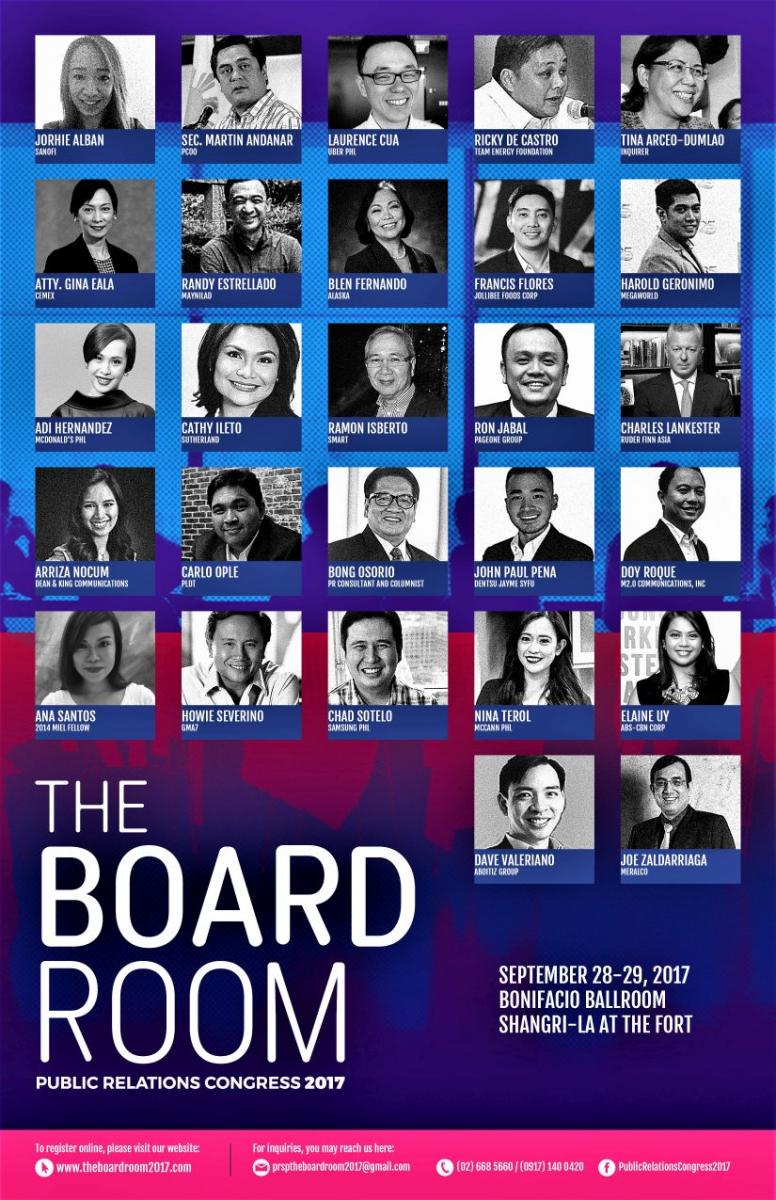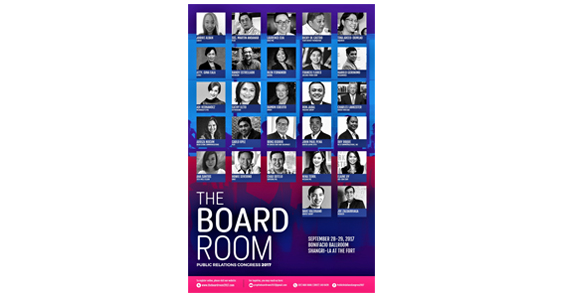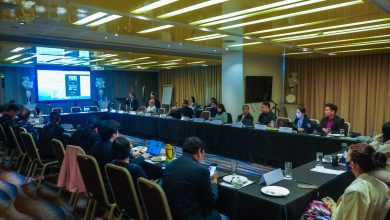By Bong R. Osorio
September is public relations month in the Philippines by virtue of Proclamation No. 1357 signed on August 13, 2007 by then president Gloria Macapagal-Arroyo. As such the Public Relations Society of the Philippines (PRSP) is tasked to hold a public relations congress every September of every year, with PR practitioners from the public and private sectors in attendance. And one of the best ways to celebrate the month-long occasion is to attend “The Boardroom,” the National PR Congress happening on September 28 to 29, 2017, Bonifacio Ballroom, Shangri-la at The Fort.
Indeed, the PR profession and industry have evolved into a major contributor to national development and the socio-economic well-being of the country. Thus, it is the avowed commitment of PR practitioners to underscore the substantial impact that the PR profession bring to bear on society and the people, and to highlight the stringent qualifications and responsibilities that this specialized field of endeavor demands of its practitioner.
As a salute to the PR month, allow me to share top ten lists of some facets of the PR industry and practice.
THE TOP10 QUOTABLE PR PRECEPTS
· It’s PR that needs to be creative. It’s PR that needs to be new and different. It’s PR that needs to be original. The best way to establish a brand is to create a new category, and creating a new category requires creative thinking of the highest order. – Al & Laura Ries
· PR is performance recognition. – Douglas Smith
· Everything you do or say is public relations. – Unknown
· PR is a mix of journalism, psychology, and lawyering – it’s an ever-changing and always interesting landscape. – Ronn Torossian
· It takes 20 years to build a reputation and five minutes to ruin it. If you think about that, you’ll do things differently. – Warren Buffet
· If I was down to the last dollar of my marketing budget, I’d spend it on PR! – Bill Gates
· It is generally much more shameful to lose a good reputation than never to have acquired it. – Pliny the Elder
· If you don’t tell your story, someone else will. – Unknown
· PR means telling the truth and working ethically – even when all the media want is headlines and all the public wants is scapegoats. Public relations fails when there is no integrity. – Viv Segal Marketing
· Some are born great, some achieve greatness, and some hire public relations officers. – Daniel J. Boorstin

THE 10 MANIFOLD CHALLENGES OF THE PROFESSION
· The persistent thought that PR is a “dark art,” while diminished, still persists. It is seen as a deal entered into by PR people with huge “relationship-building funds.” Still others describe it as organized lying, or spin doctoring. These are unmerited and unfair labels indeed and it is up to the industry to correct, if not totally reverse, the impression.
· Size or volume of the PR business can’t be accurately sourced. To this day, there are no indicative figures on how much the PR business spends annually, no rankings of multinational or local PR agencies and consultancies, not even the kind of budgets corporate communicators work with to support their deliverables.
· PR as a business continues to grow steadily. PR multinational companies have established their operations in the region. International advertising agencies with PR services compete forcefully with a number of local PR agencies. One-man bands and “lean and mean” PR consultancy groups are mushrooming, too.
· The lack of qualified professionals continues to hound the PR industry. The practice has expanded from publicity and media relations to strategic communication and digital PR, which include crisis response planning, advocacy and corporate social responsibility, government relations, community engagement, and experience management. And with its strategic function, PR moves beyond earning space and time, and as more and more PR heads deserve the distinction of getting invited to be part of their company’s executive committee.
· Everything in PR must be measured. Sophisticated PR measurement and evaluation systems are staples. These tools can demonstrate the substantive contribution of PR in achieving an organization’s short-term and long-term goals.
· Research should be in every PR person’s menu. PR professionals count communication and strategy as the most essential skills in their practice. But one cannot put those skills to good use without a foundation of research and information gathering — market and industry research, news tracking, and competitive analysis. PR requires different research methods to know clients better, define targets more efficiently and choose communication platforms more appropriately.
· A good accreditation system can erase competency questions on PR. It calls for the intensification of the value of the Accredited PR (APR), Accredited Business Communicators (ABC) or Certified PR (CPR) title. To eliminate the doubt, it should become mandatory, and appropriate educational qualifications should be secured by practitioners and demanded by employers.
· Stronger linkages and collaboration with the academe are essential. Communications programs in universities must adjust their curricula to the demands of the current practice, while PR societies must develop mechanisms that can respond to the expressed needs of the industry.
· The creation of a PR board should be marked “urgent.” It can be the arm that will institute development, influence the PR course offerings in schools, establish mechanisms for continuous professional advancement and generate greater respect for the practice. It should stimulate the leaderships of various PR organizations to help chart the course for the practice, such as defining the general principles and ethical standards for the trade and outlining the implementing rules and regulations of the profession.
· A “PR for PR” program can bring a more positive face to the profession. A communications campaign on behalf of the PR profession itself could be considered to build a stronger brand character for PR, a program that will tell and sell the story of PR and make the targeted publics appreciate its importance. After all, PR is a business and communication discipline anchored on one universal principle: Great performance that brings great results.
10 MOST USEFUL PR BOOKS
· Talespin: Public Relations Disasters by Gerry McCusker
· Value Added PR by Thomas Harris
· Creativity In PR by Andy Green
· The Fall of Advertising, The Rise of PR by Al Ries and Laura Ries
· Putting the Public Back in Public Relations by Brian Solis and Deirde Breakenridge
· When the Headline is You by Jeff Ansell
· Digital Assassination by Richard Torrenzano
· Winning the Story Wars by Jonah Sacks
· Made to Stick: Why Some Ideas Survive and Others Die by Chip and Dan Heath
· The PR Writer’s Handbook in the Digital Age by Don Spetner and Merry Aronson
There’s a new PR game to play, but the old game is still there too. PR pros still need the fundamental attributes and skills — writing and presenting skills, proactivity, human relations and work ethic, as they continue and consistently to bone up on new digital-based skills — use of social network tools, blogger relations, SEO, social media ethics, among many others demanded by a digital economy.









